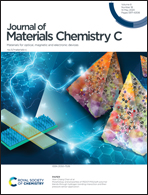Self-healing of electrical damage in thermoset polymers via anionic polymerization†
Abstract
Electrical treeing is regarded as the major factor that results in electrical damage of polymer insulation and thus shortens the lifetime and compromises the reliability of electrical power systems and power electronics. In bulk thermoset polymers, which are widely used as electrical insulation, self-healing of the electrical damage caused by treeing has rarely been reported. In this work, self-healing of electrical damage in a thermoset polymer, i.e., epoxy, is achieved through an anionic polymerization-based microcapsule approach. The epoxy matrix is modified with 2-ethyl-4-methylimidazole that initiates anionic polymerization of the healing agents and thereby repairs the electrical tree channels. The anionic polymerization is designed to be favoured in a moderate temperature range that matches with the working condition of many polymer insulation materials in electrical power systems, eliminating the need of additional stimuli that are usually required to trigger the healing reaction. It is substantialized that the electrical tree channels in the self-healing epoxy are re-built once they encounter and rupture the microcapsules, and the dielectric properties are completely recovered. This design of a self-healing material offers new possibilities for smart dielectrics that are needed in future electrical power systems and power electronics with a longer service lifetime and improved reliability.



 Please wait while we load your content...
Please wait while we load your content...